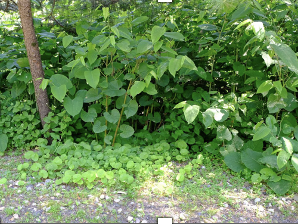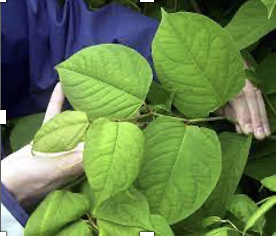Gardening Tips: Containing Invasive Japanese Knotweed

Japanese Knotweed. Photo: Wikimedia Commons
by Kate Pfordresher
Once you see it, you will see it everywhere. Japanese Knotweed is fast-growing invasive perennial that thrives along streams and rivers, the edge of forests and disturbed areas. Brought to the US as an ornamental in the late 19th century, it’s now considered one of the 100 worst invasives worldwide.

Knotweed grows from the ground in the spring and can reach from 6 to 10 feet in height by early summer. It forms dense masses along roads and rivers and quickly replaces native vegetation. Knotweed has hollow segmented stems resembling bamboo and heart-shaped leaves along its boughs. Small white flowers appear in mid-summer and the plant produces a large amount of seed in the fall. But the real problem is the roots which spread rapidly, break down the soil, and increase erosion. Without predators or known diseases, knotweed is very difficult to control without herbicides. Discarding even a small piece of root and nodule of stem can result in a new plant and stand. If dispersed on water, knotweed can rapidly spread downstream.
One recommendation for limiting knotweed is to cut the stems to the ground in late June after the plant has reached its annual height and then covering the ground with a heavy tarp. This can deprive the roots from storing of energy for the next growing season. However, it won’t kill the plant and the process will need to be repeated annually.
What you can do:
- Don’t mow Japanese Knotweed. Even small pieces of knotweed stems and rhizomes will create new plants.
- Dispose of the stems and roots with care. Lay them in the sun on a tarp or concrete surface until the plant material is completely dead and brown. Fully dead material can be composted or burned.
- Help map the incidence of knotweed in Shutesbury by joining the Subduing Knotweed Coalition and posting the location to knotweed on iNaturalist.
The Subduing Knotweed Coalition is a local community coalition formed to educate the public about knotweed, to encourage local towns to adopt best practices for road management, and to map the incidence of knotweed. The Coalition recommends posting to iNaturalist, a free app that you can download to your cellphone, to map plant and animal diversity and their potential decline. This citizen science non-profit organization provides essential information to scientists and land managers and is recommended by the MassWildLife Project of the Massachusetts Department of Fisheries and Wildlife.
For more information, see Subduing Knotweed Coalition.
Kate Pfordresher is a resident of Shutesbury and an avid gardener.
